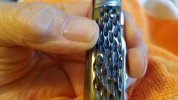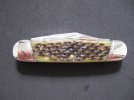Some statements of my opinion, but commonly shared among the community.
Queen / S&M have made good knives for a long time and has a great history as a cutlery manufacturer.
The resurgence of the brands came in the 1980's with the Winchester reproductions and other work done on contract.
The market share grew thru the 1990's with Case Classics, Moore Makers, Bulldog, and finally in the later part of the decade with their branded products.
By 2000 Queen was making one of the best slipjoints in the U.S.
In 2008 quality started to slip and although there were rays of light - it continued to slip until the company entered bankruptcy.
Bill was at Queen in the 1980's, 1990's and early 2000's. He left his upper management position in 2006 to start GEC.
Since most of this story is a couple decades old - I am fairly comfortable that we can start forming opinions.
I have never made the conclusion as to whether Bill left because the quality was in decline or if the quality declined due to Bill leaving. Maybe Bill is a malicious competitor and sabotaged Queen as he was leaving to eliminate the competition (I don't subscribe to this idea that I just made up; but want to cover all the bases). Or maybe, none of the above - just coincidences.
Now, a couple items not everyone knows. After Bill left Queen the company went into chaos. As one of their larger dealers - I could not even get in touch with the sales staff; much less get product onto my shelves. Once the Daniel's family bought the company they seemed to get production volume back up quickly. After they had been in charge for a year or so a couple of dealers (that were very close to Ken) kept touting how great the new products were - so it seemed as if maybe the quality was improving and I placed a 5 digit order with them. In hindsight it was probably more like Damone on Fast Times at Ridgemont High: wherever you are at is the best place to be; whatever you are doing is the best thing to be doing. Dealers don't sell a lot by saying, "this thousands of dollars worth of knives I just got in is seriously lacking in fit/finish". When the products arrived, they were so inconsistent that I had to start putting them on my website in a "graded" fashion and tiered pricing. A (no issues, good action), B(slight issues), C(issues but mostly cosmetic or repairable), and D(shouldn't have left the factory). Ken had told me they were not taking back small issues from dealers; but took offense to my new methodology to protect my customers and sent me a letter stating I was no longer the type of dealer they wanted. I had already sent back a lot of knives for obvious defects and had a balance at the factory for thousands of dollars. I told Ken that I agreed with his assessment and needed my factory credit repaid. It took months to get my money back. But other dealers had much bigger credits at the factory that were completely lost after the bankruptcy. I would frequently check in with other dealers about current Queen products; but the main one was KSF. They ended up having to give away Queen made barlows with a larger purchase because the quality was so bad. I also knew a middle manager at SMKW near the end of the Daniel's ownership that told me personally they had ceased all purchases from Queen. Also talked to a large distributor that purchased directly from Blue Ridge Knives things that didn't necessarily go out to everyone. He said they bought Queen seconds off a pallet in the warehouse at BRK - and there were several pallets. So, I don't think a little QC miss here and there was the issue.
Regarding the Heritage series specifically. I was exciting for them, but had already seen a couple glimpses of a lack of quality control. They made a line of "economy" Queen City knives that were actually a good value for the money. But my cost was in the $20-30's; so minor issues were overlooked (smashed pins, small gaps, etc.). When I received the first Heritage knives there were a lot of gaps around shields, in liners, blade grinds were very uneven, etc. This was a marked decline from what they have been producing in the past. I felt a bit like since the economy series was a hit; the new management decided this would be a way to save money on all production. I had a long conversation with Jennie (upper management at the time) and the gist of her response was that this would be the new norm.
So, there was good and bad. I am not deriving my information or opinions from stories I read or second hand information. I am basing it on dealings I have had directly and indirectly with Queen management and products for over 30 years. A product that I was crazy about for over a decade and was one of their top purchasing dealers.








